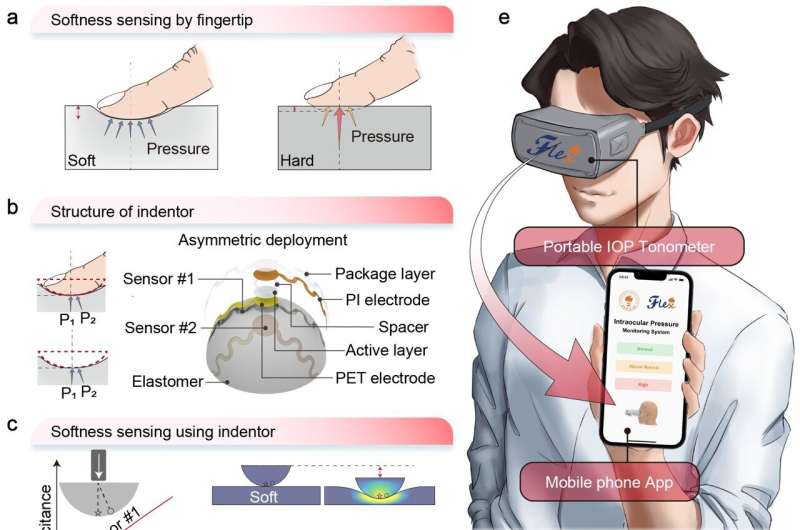This article has been reviewed according to Science X's editorial process and policies. Editors have highlighted the following attributes while ensuring the content's credibility:
fact-checked
trusted source
proofread
A new displacement-pressure biparametrically regulated softness sensory system for intraocular pressure monitoring

High intraocular pressure (IOP) is a significant risk factor for glaucoma. Current IOP tests are mostly conducted in hospitals, while portable home tonometers that provide convenient IOP monitoring are expensive and often suffer from large errors (> 5 mmHg). There is a pressing need for the development of a convenient, low-cost, and highly accurate eye pressure monitor.
To address the challenges, a team led by Professor Chuan Fei Guo at the Southern University of Science and Technology and Professor Cunjiang Yu at Pennsylvania State University has proposed a principle for IOP monitoring through the identification of eyeball softness. Integrating deep learning, the team designed a displacement-pressure biparametrically controlled biomimetic softness sensory system, and made a portable IOP tonometer capable of highly accurate assessment of IOP.
The team's work is published in the journal National Science Review.
Ph.D. student Yu Cheng and undergraduate student Yifei Zhan from the Southern University of Science and Technology are the equally contributed first authors, and Professor Chuan Fei Guo and Professor Cunjiang Yu serve as co-corresponding authors.
The touch and recognition of soft objects by human fingers rely on not only pressure distribution but also deformation information. Inspired by this, the team integrated two asymmetrically deployed high-sensitivity (0~60 kPa, 736.1 kPa-1) iontronic pressure sensors on a hemispherical elastomeric indentor to mimic the touch of human fingers. Different from the force control mode reported in previous works, the displacement-pressure control mode allows the collection of much comprehensive pressure and deformation information to reflect the softness of the contacted object.
Utilizing a deep learning model, the sensory system enables the accurate classification of 20 common objects in daily life with an accuracy exceeding 99%. The system's design promotes high training efficiency, accuracy, and robustness due to its multi-segment displacement control mode.
Based on the sensory system, the team developed and custom-made a portable and wearable IOP monitor that identifies IOP health by recognizing eyeball softness. The monitor integrates two high-precision micro linear actuators and two biomimetic softness sensors, with adjustable screws to accommodate varying user needs. This portable IOP monitor costs approximately $200, significantly lower than that of commercial portable tonometers such as the ICare IC-100, which costs around $2,000.
Unlike other IOP tonometers, this device measures IOP in a closed-eye status without a direct contact with the eyeball. Since eyeballs are significantly harder than the eyelid, the variability in eyelid softness and thickness across different individuals do not affect the testing results. The team collected data from 50 eyeballs of 25 volunteers for deep learning and testing validation, demonstrating that this portable IOP monitor surpasses commercial alternatives in accuracy, repeatability, and consistency.
In conclusion, this work presents a principle to monitor IOP based on eyeball softness identification, involving the design of a biomimetic softness sensor and the development of an intelligent softness sensory system. This has led to the creation of a portable IOP monitor that offers a high-comfort, high-accuracy, and low-cost solution for not only IOP monitoring, but also softness sensing in other health care applications and robotics.
More information: Yu Cheng et al, Displacement-pressure biparametrically regulated softness sensory system for intraocular pressure monitoring, National Science Review (2024). DOI: 10.1093/nsr/nwae050




















